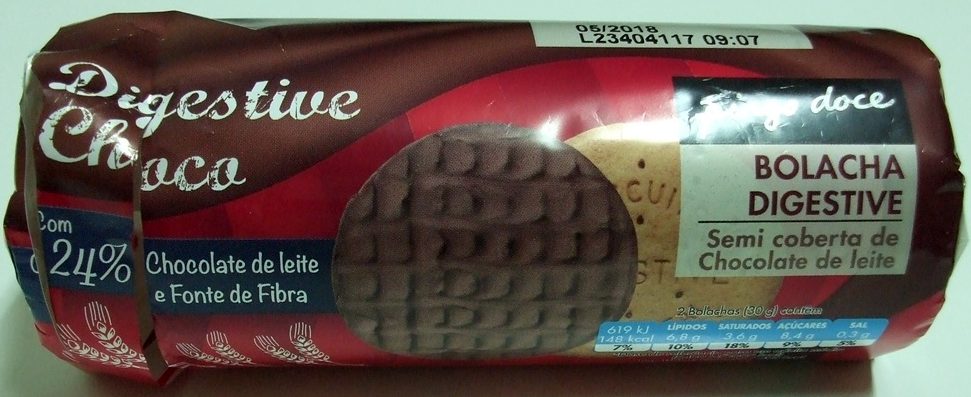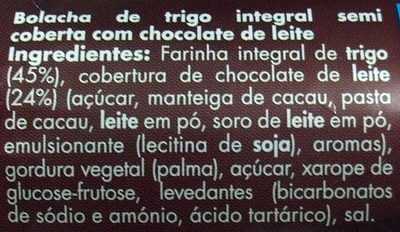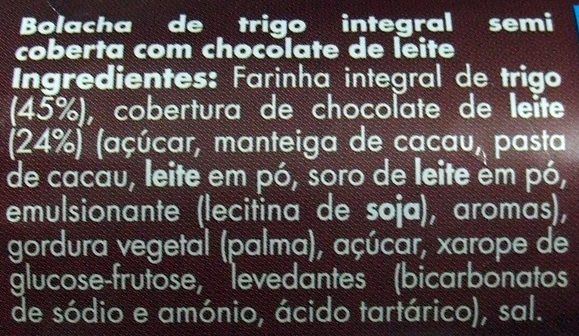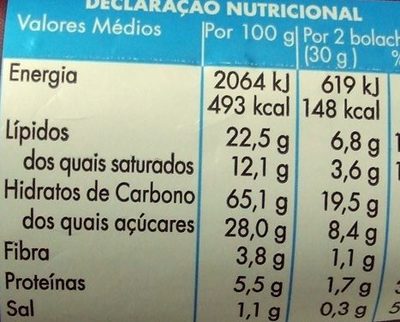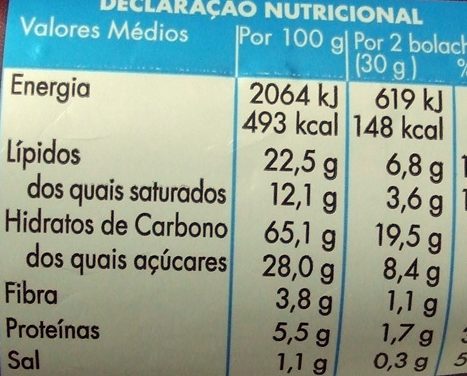Help us make food transparency the norm!
As a non-profit organization, we depend on your donations to continue informing consumers around the world about what they eat.
The food revolution starts with you!
Bolacha digestiva com chocolate - Pingo Doce - 300 g
Bolacha digestiva com chocolate - Pingo Doce - 300 g
This product page is not complete. You can help to complete it by editing it and adding more data from the photos we have, or by taking more photos using the app for Android or iPhone/iPad. Thank you!
×
Barcode: 5601009979301 (EAN / EAN-13)
Common name: Bolacha de trigo integral semi coberta com chocolate de leite
Quantity: 300 g
Packaging: Plastic
Brands: Pingo Doce
Categories: Snacks, Sweet snacks, Biscuits and cakes, Biscuits
Stores: Pingo Doce
Countries where sold: Portugal
Matching with your preferences
Health
Ingredients
-
18 ingredients
: Farinha integral de trigo (45%), cobertura de chocolate de leite (24%) (açúcar, manteiga de cacau, pasta de cacau, leite em pó, soro de leite em pó, emulsionante (lecitina de soja), aromas), gordura vegetal (palma), açúcar, xarope de glucose-frutose, levedantes (bicarbonatos de sódio e amónio, ácido tartárico), sal.Allergens: Gluten, Milk, SoybeansTraces: Nuts
Food processing
-
Ultra processed foods
Elements that indicate the product is in the 4 - Ultra processed food and drink products group:
- Ingredient: Emulsifier
- Ingredient: Flavouring
- Ingredient: Glucose
- Ingredient: Whey
Food products are classified into 4 groups according to their degree of processing:
- Unprocessed or minimally processed foods
- Processed culinary ingredients
- Processed foods
- Ultra processed foods
The determination of the group is based on the category of the product and on the ingredients it contains.
Additives
-
E334 - L(+)-tartaric acid
Tartaric acid: Tartaric acid is a white, crystalline organic acid that occurs naturally in many fruits, most notably in grapes, but also in bananas, tamarinds, and citrus. Its salt, potassium bitartrate, commonly known as cream of tartar, develops naturally in the process of winemaking. It is commonly mixed with sodium bicarbonate and is sold as baking powder used as a leavening agent in food preparation. The acid itself is added to foods as an antioxidant and to impart its distinctive sour taste. Tartaric is an alpha-hydroxy-carboxylic acid, is diprotic and aldaric in acid characteristics, and is a dihydroxyl derivative of succinic acid.Source: Wikipedia
Ingredients analysis
-
Palm oil
Ingredients that contain palm oil: Palm
-
Non-vegan
Non-vegan ingredients: Milk powder, Whey powderSome ingredients could not be recognized.
We need your help!
You can help us recognize more ingredients and better analyze the list of ingredients for this product and others:
- Edit this product page to correct spelling mistakes in the ingredients list, and/or to remove ingredients in other languages and sentences that are not related to the ingredients.
- Add new entries, synonyms or translations to our multilingual lists of ingredients, ingredient processing methods, and labels.
If you would like to help, join the #ingredients channel on our Slack discussion space and/or learn about ingredients analysis on our wiki. Thank you!
-
Vegetarian status unknown
Unrecognized ingredients: pt:cobertura-de-chocolate-de-leite, pt:bicarbonatos-de-sodio-e-amonioSome ingredients could not be recognized.
We need your help!
You can help us recognize more ingredients and better analyze the list of ingredients for this product and others:
- Edit this product page to correct spelling mistakes in the ingredients list, and/or to remove ingredients in other languages and sentences that are not related to the ingredients.
- Add new entries, synonyms or translations to our multilingual lists of ingredients, ingredient processing methods, and labels.
If you would like to help, join the #ingredients channel on our Slack discussion space and/or learn about ingredients analysis on our wiki. Thank you!
-
Details of the analysis of the ingredients
We need your help!
Some ingredients could not be recognized.
We need your help!
You can help us recognize more ingredients and better analyze the list of ingredients for this product and others:
- Edit this product page to correct spelling mistakes in the ingredients list, and/or to remove ingredients in other languages and sentences that are not related to the ingredients.
- Add new entries, synonyms or translations to our multilingual lists of ingredients, ingredient processing methods, and labels.
If you would like to help, join the #ingredients channel on our Slack discussion space and/or learn about ingredients analysis on our wiki. Thank you!
: Farinha integral de _trigo_ 45%, cobertura de chocolate de _leite_ 24% (açúcar, manteiga de cacau, pasta de cacau, _leite_ em pó, soro de _leite_ em pó, emulsionante (lecitina de _soja_), aromas), gordura vegetal (palma), açúcar, xarope de glucose-frutose, levedantes (bicarbonatos de sódio e amónio, ácido tartárico), sal- Farinha integral de _trigo_ -> en:whole-wheat-flour - vegan: yes - vegetarian: yes - ciqual_proxy_food_code: 9410 - percent_min: 45 - percent: 45 - percent_max: 45
- cobertura de chocolate de _leite_ -> pt:cobertura-de-chocolate-de-leite - percent_min: 24 - percent: 24 - percent_max: 24
- açúcar -> en:sugar - vegan: yes - vegetarian: yes - ciqual_proxy_food_code: 31016 - percent_min: 3.42857142857143 - percent_max: 24
- manteiga de cacau -> en:cocoa-butter - vegan: yes - vegetarian: yes - ciqual_food_code: 16030 - percent_min: 0 - percent_max: 12
- pasta de cacau -> en:cocoa-paste - vegan: yes - vegetarian: yes - ciqual_proxy_food_code: 16030 - percent_min: 0 - percent_max: 8
- _leite_ em pó -> en:milk-powder - vegan: no - vegetarian: yes - ciqual_proxy_food_code: 19044 - percent_min: 0 - percent_max: 6
- soro de _leite_ em pó -> en:whey-powder - vegan: no - vegetarian: maybe - percent_min: 0 - percent_max: 4.8
- emulsionante -> en:emulsifier - percent_min: 0 - percent_max: 4
- lecitina de _soja_ -> en:soya-lecithin - vegan: yes - vegetarian: yes - ciqual_food_code: 42200 - percent_min: 0 - percent_max: 4
- aromas -> en:flavouring - vegan: maybe - vegetarian: maybe - percent_min: 0 - percent_max: 3.42857142857143
- gordura vegetal -> en:vegetable-fat - vegan: yes - vegetarian: yes - from_palm_oil: maybe - percent_min: 6.2 - percent_max: 24
- palma -> en:palm - vegan: yes - vegetarian: yes - from_palm_oil: yes - ciqual_food_code: 16129 - percent_min: 6.2 - percent_max: 24
- açúcar -> en:sugar - vegan: yes - vegetarian: yes - ciqual_proxy_food_code: 31016 - percent_min: 1.75 - percent_max: 15.5
- xarope de glucose-frutose -> en:glucose-fructose-syrup - vegan: yes - vegetarian: yes - ciqual_food_code: 31077 - percent_min: 0 - percent_max: 9.75
- levedantes -> en:raising-agent - percent_min: 0 - percent_max: 7.3125
- bicarbonatos de sódio e amónio -> pt:bicarbonatos-de-sodio-e-amonio - percent_min: 0 - percent_max: 7.3125
- ácido tartárico -> en:e334 - vegan: yes - vegetarian: yes - percent_min: 0 - percent_max: 3.65625
- sal -> en:salt - vegan: yes - vegetarian: yes - ciqual_food_code: 11058 - percent_min: 0 - percent_max: 1.1
Nutrition
-
Bad nutritional quality
⚠ ️Warning: the amount of fruits, vegetables and nuts is not specified on the label, it was estimated from the list of ingredients: 0This product is not considered a beverage for the calculation of the Nutri-Score.
Positive points: 4
- Proteins: 3 / 5 (value: 5.5, rounded value: 5.5)
- Fiber: 4 / 5 (value: 3.8, rounded value: 3.8)
- Fruits, vegetables, nuts, and colza/walnut/olive oils: 0 / 5 (value: 0, rounded value: 0)
Negative points: 26
- Energy: 6 / 10 (value: 2063, rounded value: 2063)
- Sugars: 6 / 10 (value: 28, rounded value: 28)
- Saturated fat: 10 / 10 (value: 12.1, rounded value: 12.1)
- Sodium: 4 / 10 (value: 440, rounded value: 440)
The points for proteins are not counted because the negative points are greater or equal to 11.
Nutritional score: (26 - 4)
Nutri-Score:
-
Nutrient levels
-
Fat in high quantity (22.5%)
What you need to know- A high consumption of fat, especially saturated fats, can raise cholesterol, which increases the risk of heart diseases.
Recommendation: Limit the consumption of fat and saturated fat- Choose products with lower fat and saturated fat content.
-
Saturated fat in high quantity (12.1%)
What you need to know- A high consumption of fat, especially saturated fats, can raise cholesterol, which increases the risk of heart diseases.
Recommendation: Limit the consumption of fat and saturated fat- Choose products with lower fat and saturated fat content.
-
Sugars in high quantity (28%)
What you need to know- A high consumption of sugar can cause weight gain and tooth decay. It also augments the risk of type 2 diabetes and cardio-vascular diseases.
Recommendation: Limit the consumption of sugar and sugary drinks- Sugary drinks (such as sodas, fruit beverages, and fruit juices and nectars) should be limited as much as possible (no more than 1 glass a day).
- Choose products with lower sugar content and reduce the consumption of products with added sugars.
-
Salt in moderate quantity (1.1%)
What you need to know- A high consumption of salt (or sodium) can cause raised blood pressure, which can increase the risk of heart disease and stroke.
- Many people who have high blood pressure do not know it, as there are often no symptoms.
- Most people consume too much salt (on average 9 to 12 grams per day), around twice the recommended maximum level of intake.
Recommendation: Limit the consumption of salt and salted food- Reduce the quantity of salt used when cooking, and don't salt again at the table.
- Limit the consumption of salty snacks and choose products with lower salt content.
-
-
Nutrition facts
Nutrition facts As sold
for 100 g / 100 mlAs sold
per serving (2 bolachas 30 g)Compared to: Biscuits Energy 2,063 kj
(493 kcal)619 kj
(148 kcal)+6% Fat 22.5 g 6.75 g +12% Saturated fat 12.1 g 3.63 g +33% Carbohydrates 65.1 g 19.5 g +2% Sugars 28 g 8.4 g -3% Fiber 3.8 g 1.14 g +32% Proteins 5.5 g 1.65 g -12% Salt 1.1 g 0.33 g +82% Fruits‚ vegetables‚ nuts and rapeseed‚ walnut and olive oils (estimate from ingredients list analysis) 0 % 0 %
Environment
-
Eco-Score C - Moderate environmental impact
⚠ ️Select a country in order to include the full impact of transportation.The Eco-Score is an experimental score that summarizes the environmental impacts of food products.→ The Eco-Score was initially developped for France and it is being extended to other European countries. The Eco-Score formula is subject to change as it is regularly improved to make it more precise and better suited to each country.Life cycle analysis
-
Average impact of products of the same category: B (Score: 69/100)
Category: Biscuit (cookie)
Category: Biscuit (cookie)
- PEF environmental score: 0.35 (the lower the score, the lower the impact)
- including impact on climate change: 2.88 kg CO2 eq/kg of product
Stage Impact Agriculture
80.5 %Processing
11.8 %Packaging
3.1 %Transportation
3.2 %Distribution
1.4 %Consumption
0.0 %
Bonuses and maluses
-
Missing origins of ingredients information
Malus: -5
⚠ ️ The origins of the ingredients of this product are not indicated.
If they are indicated on the packaging, you can modify the product sheet and add them.
If you are the manufacturer of this product, you can send us the information with our free platform for producers.
-
Ingredients that threatens species
Malus: -10
Contains palm oil
Tropical forests in Asia, Africa and Latin America are destroyed to create and expand oil palm tree plantations. The deforestation contributes to climate change, and it endangers species such as the orangutan, the pigmy elephant and the Sumatran rhino.
-
Packaging with a medium impact
Malus: -10
Shape Material Recycling Impact Unknown Plastic High ⚠ ️ The information about the packaging of this product is not sufficiently precise (exact shapes and materials of all components of the packaging).⚠ ️ For a more precise calculation of the Eco-Score, you can modify the product page and add them.
If you are the manufacturer of this product, you can send us the information with our free platform for producers.
Eco-Score for this product
-
Impact for this product: C (Score: 44/100)
Product: Bolacha digestiva com chocolate - Pingo Doce - 300 g
Life cycle analysis score: 69
Sum of bonuses and maluses: -25
Final score: 44/100
-
Carbon footprint
-
Equal to driving 1.5 km in a petrol car
288 g CO² per 100g of product
The carbon emission figure comes from ADEME's Agribalyse database, for the category: Biscuit (cookie) (Source: ADEME Agribalyse Database)
Stage Impact Agriculture
82.9 %Processing
7.9 %Packaging
3.8 %Transportation
4.7 %Distribution
0.7 %Consumption
0.0 %
Packaging
-
Packaging with a medium impact
-
Packaging parts
(Plastic)
-
Packaging materials
Material % Packaging weight Packaging weight per 100 g of product Plastic
-
Transportation
-
Origins of ingredients
Missing origins of ingredients information
⚠ ️ The origins of the ingredients of this product are not indicated.
If they are indicated on the packaging, you can modify the product sheet and add them.
If you are the manufacturer of this product, you can send us the information with our free platform for producers.Add the origins of ingredients for this product Add the origins of ingredients for this product
Threatened species
-
Contains palm oil
Drives deforestation and threatens species such as the orangutan
Tropical forests in Asia, Africa and Latin America are destroyed to create and expand oil palm tree plantations. The deforestation contributes to climate change, and it endangers species such as the orangutan, the pigmy elephant and the Sumatran rhino.
Report a problem
-
Incomplete or incorrect information?
Category, labels, ingredients, allergens, nutritional information, photos etc.
If the information does not match the information on the packaging, please complete or correct it. Open Food Facts is a collaborative database, and every contribution is useful for all.
Data sources
Product added on by wist
Last edit of product page on by packbot.
Product page also edited by kiliweb, yuka.ZEtFK0RhMVJqTlFqcGM4czRUT0o1bzBybW8yeVhHaUdLODArSVE9PQ.

